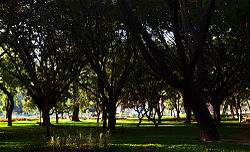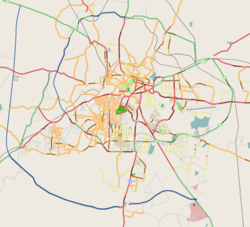Cubbon Park
Sri Chamarajendra Park | |
|---|---|
Neighbourhood | |
 | |
| Coordinates: 12°58′30″N 77°35′36″E / 12.97500°N 77.59333°E | |
| Country | |
| State | Karnataka |
| District | Bengaluru Urban |
| Metro | Bengaluru |
| Founded | 1870 |
| Founded by | Sir John Meade[1] |
| Named for | Maharaja Chamarajendra Wadiyar X |
| Government | |
| • Body | Department of Horticulture, Government of Karnataka |
| Area | |
| • Total | 1.2 km2 (0.5 sq mi) |
| Languages | |
| • Official | Kannada |
| Time zone | UTC+5:30 (IST) |
| Pin Code | 560001 |
| Website | http://www.horticulture.kar.nic.in/cubbon.htm |

Cubbon Park, officially Sri Chamarajendra Park,[1] is a landmark park in Bengaluru, located in the heart of the city in the Central Administrative Area. Originally created in 1870 under Major General Richard Sankey, then British Chief Engineer of Mysore State, it covered an area of 100 acres (0.40 km2). Subsequent expansion has since taken place and the park's area is now reported to be 300 acres (1.2 km2).[2] It has a rich recorded history of abundant flora and fauna plantations coupled with numerous impressive and aesthetically located buildings and statues of famous personages, in its precincts.[3][4]
This public park was first named as Meade's Park after Sir John Meade, the acting commissioner of Mysuru in 1870 and subsequently renamed as Cubbon Park after the longest-serving commissioner of the time, Sir Mark Cubbon, when Meade left for a new assignment in Baroda in 1873. To commemorate the Silver Jubilee of Sri Krishnaraja Wodeyar's rule in Mysore State, in 1927, the park was again renamed as Sri. Chamarajendra Park, in memory of the 19th-century ruler of the state Sri Chamarajendra Wodeyar (1868–94), during whose rule the park came into existence.[5][6]
The landscaping in the park creatively integrates natural rock outcrops with thickets of trees, massive bamboos, with grassy expanse and flowerbeds and the monuments within its limits, regulated by the Horticulture Department of the Government of Karnataka. The predominantly green area of the park has many motorable roads, and the well-laid-out walking paths running through the park are frequented by early morning walkers and the naturalists who study plants in the tranquil natural environment.[6] Tourists visiting this park in the city of Bengaluru have nicknamed the city itself as 'Garden City'.[7]
The importance of the park to the city's environment is best stated by two urban architects who have won the national competition to design 'Freedom Park'.
- ^ a b "Sri Chamarajendra (Cubbon) Park". Archived from the original on 10 January 2024. Retrieved 4 January 2024.
- ^ "Bangalore Tourist Attractions". Archived from the original on 29 August 2017. Retrieved 6 July 2012.
- ^ Archived August 7, 2011, at the Wayback Machine[dead link]
- ^ Cubbon Park
- ^ "Know Your City: Bengaluru's famed Cubbon Park and the namesake who never saw it completed". 2 October 2023. Retrieved 10 November 2024.
- ^ a b http://www.horticulture.kar.nic.in/ Archived 20 August 2017 at the Wayback Machine Gardens Cubbon Park
- ^ Cubbon Park
